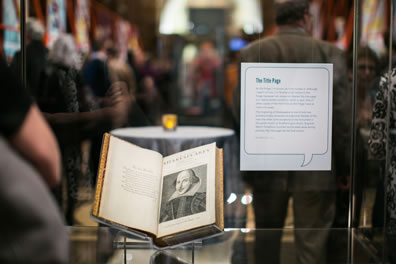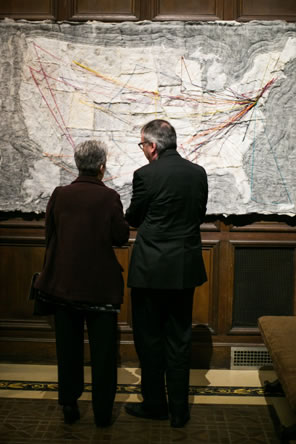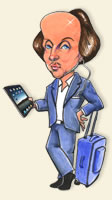The Folger Library
First Folio's Blockbuster Tour Comes Home

The First Folio–20 of them–is the centerpiece of an exhibit at the Folger Library telling the story of that institution's yearlong tour to every state and terriitory of "the book that gave us Shakespeare." Below, a tactile map of the tour. Photos by Yassine El Mansouri, Folger Library.
When the Folger Library in Washington, D.C., announced in March 2015 its intent to mark the 400th anniversary of William Shakespeare's death by touring the First Folio to every state and territory in the United States, I posted the news on Shakespeareances.com, listing the planned stops. I watched as reactions rolled in, ranging from "Hallelujah! it's coming here" to "Darn [or that word's gutteral equivalent] it'll be at the other end of the state."
This was a rarity: a rare book going on tour. How do you make a book compelling? Would anybody but bibliophiles care? These were real questions the Folger and its partner in the enterprise, the Cincinnati Museum Center, asked themselves when they started planning the tour.
However, the First Folio is not just any rare book; it is an inherently compelling book. It is considered by many to be the second-most important book in Western Civilization after the Bible, but unlike the Bible there is only one version of the First Folio (not really, but we'll get to that). The host of the First Folio's stop in Charlottesville, Virginia, described the excitement in her community as the equivalent of a celebrity coming to town. Every site the First Folio visited mounted a number of celebrations around the book. People proposed marriage in front of the book. Guards became so enamored of the book and the atmosphere around it that they were spotted bending over the display case reading when nobody was around, and many ended up serving as makeshift docents for visitors.
"It was one of the most moving things I've ever been a part of," said Michael Witmore, director of the Folger Library, who accompanied the First Folio on some of its 71,000-mile journey, where it was seen by a half million people, according to the library. And now, the First Folios that made that trek have come home to roost for one last exhibit: an exhibit about the touring exhibit.
"First Folio: Shakespeare's American Tour," running through Jan. 22, 2017, is a fascinating exhibit on several levels. It's a story of the First Folio itself, it's an insider's look at the various editions of the First Folio, and it's a tale of the book's journey to 54 locations and the logistics that went into that effort. The exhibit not only has the four-panel display that accompanied the First Folio at every stop, it contains one of the wheeled crates used to transport the book and its case. Such was the effort that went into this tour that each book had a strict "light budget" based on the total number of hours that it could be exposed.
Of the 82 First Folios in its collection, the Folger chose 18 copies to send out in waves of six, with one "understudy" edition on standby. Sixteen of these copies had never left the Folger's famed vault since the library opened in 1932 except during World War II when the entire collection was secretly sent to Amherst College in Massachusetts. Eighteen was a logistical choice, but it had serendipitous significance: 18 plays were published for the first time in the First Folio, without which they all might have been lost to us. In the exhibit, each of the First Folios are opened to the title page of one of those plays:
- Henry VI, Part One
- Henry VIII
- The Winter's Tale
- King John
- Twelfth Night
- Measure for Measure
- Cymbeline
- The Two Gentlemen of Verona
- The Taming of the Shrew
- All's Well that Ends Well
- As You Like It
- The Comedy of Errors
- The Tempest
- Coriolanus
- Timon of Athens
- Julius Caesar
- Antony and Cleopatra
- Macbeth
For the touring exhibit, the book was opened to Hamlet's "To be or not to be" speech, and the understudy book gets to perform that task in this homecoming exhibit. Including the First Folio permanently on public display at the Folger, the 20 editions in this exhibit constitute the largest-ever public display of First Folios.
As such, there's much to learn about the infinite varieties of this book. Troilus and Cressida was added after the First Folio's press run had started, so not all copies had that play; over the years, many owners missing it added the script via facsimiles or with pages from the Second Folio and subsequent editions. Each book is named, adding to their individual personalities. Among those in the exhibit, the Purple Copy is named for the purple tint on some of its pages and the Golden Retriever Copy for its yellow-brown goatskin binding. The Jane Katherine copy has her name inscribed in it, and the Package Deal Copy was purchased with accompanying Second and Fourth Folios. Other names—the 15 Shilling Copy, the Public Library Copy, the Scissors Copy, and the Stage Direction Copy—are self-explanatory, as is the First First Folio, Henry and Emily Folger's initial purchase of the book that would lead to their world-famous collection containing more First Folios than anywhere else (235 copies are known to exist; researchers believe 750 were printed).
 The exhibit describes the journey each book took and the highlights of their visits. Hosts were encouraged to allow free admission to the exhibit and required to do four free programs in association with the Folio exhibit, including one workshop for teachers and one event for families. But many locales did so much more: a total 1,369 special events surrounded First Folio visits, which began Jan. 4, 2016, at the Sam Noble Museum in Norman, Oklahoma, (where the First Folio shared space with a dinosaur) and will end Jan. 8, 2017, with its visit to the Parthenon in Nashville, Tennessee.
The exhibit describes the journey each book took and the highlights of their visits. Hosts were encouraged to allow free admission to the exhibit and required to do four free programs in association with the Folio exhibit, including one workshop for teachers and one event for families. But many locales did so much more: a total 1,369 special events surrounded First Folio visits, which began Jan. 4, 2016, at the Sam Noble Museum in Norman, Oklahoma, (where the First Folio shared space with a dinosaur) and will end Jan. 8, 2017, with its visit to the Parthenon in Nashville, Tennessee.
Along the way, the First Folio saw a "Wanted" poster for "Willy the Kid" in New Mexico; Shakespeare posters from around the world in Wisconsin; a 3D Virtual London in Florida; a fashion show in Puerto Rico; ShakesBeer in the Park in West Virginia; a jazz funeral for Shakespeare in Louisiana; and visits from mascots: Victor E. Bear of the University of Central Arkansas, the University of Connecticut's Jonathan the Husky, and the Rushmore presidents in South Dakota. In Vermont, babies and toddlers got storytelling time with Romeo and Juliet. In Kansas, Oberon and Titania fought over custody for the changeling boy in a mock trial. In Colorado, Fiske Planetarium displayed constellations and eclipses that influenced Shakespeare. In Iowa, visitors could play a video game called "Play the Knave."
Speaking of playing, two sites connected the First Folio to local institutions linked to games. In Kentucky, the Louisville Slugger Museum and Factory presented "The Shakespearean Baseball Game: A Comedy of Errors, Hits, and Runs." That same book, the Golden Retriever Copy, went on to Las Vegas, Nevada, where David Schwartz, director of the Center for Gaming Research at the University of Nevada Las Vegas, offered up an interactive talk called "Hazard All He Hath: Shakespeare's Gambling World," and visitors learned how to play 16th and 17th century games of chance using "Shakespeare bucks."
Sites presented book-making demonstrations, stage combat demonstrations, concerts (with original renaissance instruments in Mississippi), and films based on Shakespeare plays (including in Massachusetts the first American broadcast of a Shakespeare play, Julius Caesar, filmed at the Folger Theatre in 1949). In Illinois, on the eve of opening the exhibit, the Lake County Discovery Museum realized it had the costume Marlon Brando wore when he played Antony in the 1953 film of Julius Caesar, and it was added to the First Folio display. Many presented staged events, including a ShakesQueer show in Washington, while in North Carolina theater companies took part in a 24/7 marathon of all 38 Shakespeare plays over five days, including a Twelfth Night at midnight performed in pajamas.
The decision to take the exhibit to Duluth, Minnesota, instead of the populous Twin Cities region caused an outpouring of appreciation in that northeast corner of the state, said Witmore, who was on hand when the exhibit opened there. Every element of the Duluth community—arts, academics, business, and political leaders—came together as hosts, and the newspaper ran an eight-page special insert on the First Folio. The tour prompted two new translations of the "To be" speech, in Hawaiian and Kiowa, but a planned translation in Lakota didn't come about because that language has no equivalent for the verb "To be."
And in San Diego, California, people left messages sharing how Shakespeare's words are still relevant today. "Shakespeare has the best questions," said one; another wrote, "He helped me fall in love." Amen.
The tour was funded with a major grant from the Naitonal Endowment for the Humanities and support from Google.org, Vinton and Sigrid Cerf, the British Council, and Stuart and Mimi Rose.
December 6, 2016
If you have Shakespearean news to share, e-mail editorial@shakespeareances.com



 Find additional Shakespeareances
Find additional Shakespeareances